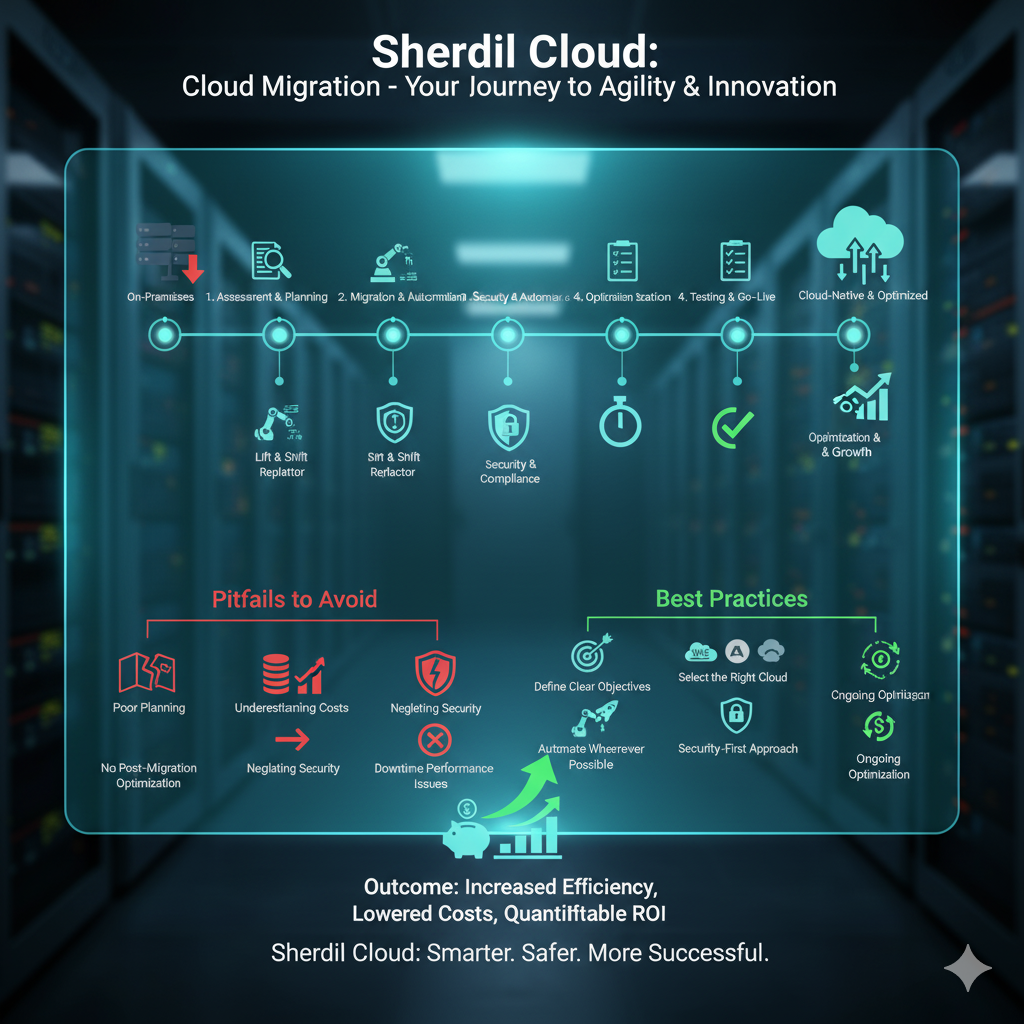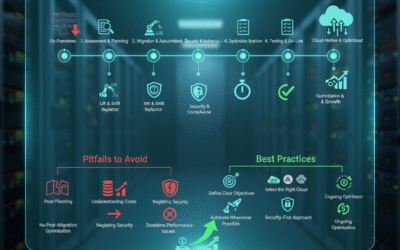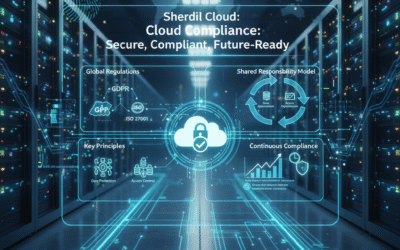Cloud migration has emerged as one of the most strategic steps for businesses looking to increase agility, save costs, and drive innovation at a faster pace. Whether migrating from on-premises infrastructure to AWS, Azure, or Google Cloud, the migration process can unleash tremendous potential — but only if executed correctly.
At Sherdil Cloud, we’ve helped businesses across industries navigate complex migrations with precision, security, and minimal disruption. Over the years, we’ve seen both the success stories and the struggles that come with moving to the cloud. This article will highlight the common pitfalls organizations face during migration and the best practices our experts recommend to ensure a smooth, cost-effective, and future-proof transition.
Understanding Cloud Migration
Cloud migration is not merely about migrating data or applications from one place to another. It’s re-architecting your digital foundation for scalability, resilience, and performance.
There are generally three broad migration strategies:
-Lift and Shift (Rehosting): Simply moving applications as-is to the cloud without re-designing them.
-Replatforming: Making a few optimizations to leverage cloud advantages like managed databases or load balancing.
-Refactoring/Re-architecting: Entirely redesigning applications to take advantage of cloud-native technologies such as containers, microservices, and server less computing.
-Each method has its advantages and disadvantages, and the best option is based on your business objectives, existing infrastructure, and budget.
Common Pitfalls to Avoid During Cloud Migration
Despite the fact that the cloud provides infinite advantages, numerous migrations are unsuccessful due to improper planning, poor goals, or inferior execution. Below are the most common errors our staff at Sherdil Cloud frequently assist customers in staying away from:
1.Proper Planning and Estimation
One of the primary reasons for failed cloud migrations is diving in without a plan. Organizations tend to underestimate application, workload, and security dependencies.
What to avoid:
Migrating all at once without proper prioritization.
Overlooking interdependencies between systems.
Lack of defining distinct KPIs for success.
Sherdil Cloud methodology:
We start all migrations with a thorough cloud readiness assessment, breaking down workloads, compliance requirements, and performance targets. This enables us to develop a step-by-step migration plan that reduces risk and downtime.
2. Underestimating Costs
Although cloud uptake is supposed to reduce costs, organizations still suffer bill shock upon migration when resources are not managed correctly or there is no cost tracking. Avoid:
-Idle or unused instances being run.
-Storage lifecycle policies being ignored.
-Reserved instances or auto scaling not being utilized.
Sherdil Cloud’s solution:
We put in place FinOps (Financial Operations) practices that link cloud expenditures with business objectives. Through the use of tools such as AWS Cost Explorer, Azure Cost Management, and bespoke dashboards, we enable organizations to right-size their resources and have complete visibility into their cloud expenditures.
3. Neglecting Security and Compliance
Security cannot be an afterthought in migration. Most organizations migrate data to the cloud without realizing how security controls are different from their native environments.
Do not do:
-Depend too much on the native security built into the cloud provider.
-Don’t forget to encrypt data at rest and in transit.
-Overlook compliance frameworks such as GDPR, ISO 27001, or SOC 2.
Sherdil Cloud’s solution:
Our security-first migration strategy involves installing Identity and Access Management (IAM), encryption, Zero Trust architecture, and compliance audits. We make each migration secure and regulation-ready from day one.
4. Downtime and Performance Issues
Inadequate migration sequencing or lack of dependencies can cause unplanned downtime — impacting operations and customer experience.
What not to do:
-Migration of mission-critical systems without backups or failover.
-Not testing applications after migration.
-Ignoring latency and bandwidth requirements.
Sherdil Cloud’s solution:
We perform live migration simulations, test failover mechanisms, and validate all workloads prior to the final switch. Our phased approach causes minimal disruption and guarantees high availability.
Best Practices for Successful Cloud Migration
Sherdil Cloud has created an improved framework on best practices that can guarantee a safe and efficient migration.
- Define Clear Objectives
Any migration must start with insight – why are you going to the cloud? It can be through cost efficiency, agility, scalability, or innovation but the main thing is that the objectives should be defined so that the entire process can be guided by it.
Sherdil Cloud collaborates with its clients to achieve the technical migration objectives aligned with the business outcomes, and every activity is expected to bring specific ROI.
- Select the Appropriate Cloud Provider
All the three cloud providers provide different advantages, namely, AWS, Azure, and Google Cloud.
AWS: Scalability and enterprise-level tools.
Azure: Suits well in hybrid environments as well as Microsoft integrations.
Google Cloud: Good at analytics and AI, and the modern app development.
Our specialists review your current workloads and prescribe the platform that is most appropriate to you based on your business vision over time or even a multi-cloud approach.
- Pilot Migration
A pilot migration enables you to implement a strategy in a small scale and then roll it out to an organization-wide level. This is useful in determining weaknesses of security, performance, or compatibility at an early stage.
In Sherdil Cloud, we do proof-of-concept migrations to gauge system performance and optimize settings prior to a scale-up.
- Automate Wherever Possible
Automation lowers the possibility of human error and accelerates deployment. We do this by automating provisioning, configuration and scaling using tools such as Terraform, Ansible and CloudFormation.
It is an Infrastructure-as-Code (IaC) methodology that is consistent, involves less manual handling, and facilitates rollback in case of necessity.
- Put Security on the First Page
Every level of migration plan should be secured. Sherdil Cloud incorporates DevSecOps practices, which add security checks to CI/CD pipelines – to make sure your cloud is compliant and secure even during its evolution.
Another tool that we use to prevent vulnerabilities in real time is the use of continuous monitoring and threat detecting tools.
- Train and Empower Your Team
The reason that a successful migration is not just about technology is because it is all about people. Training on clouds assists teams to learn about new tools, processes and governance models.
Sherdil Cloud offers specialized training to make IT teams and executives comfortable enough to run cloud environments after the migration.
- On-going Optimization and Governance
Continuous improvement is important once in the cloud. Sherdil Cloud enforces cloud governance models that establish cost control, compliance and resource utilization policies.
Via continuous audits, automation and AI-based surveillance, we assist clients in maintaining optimal performance and cost-effectiveness way beyond migration.
The Sherdil Cloud Advantage
Going to the cloud is a big step to make, a step that could enable agility, innovation and long term savings when carried out in a strategic manner.
At Sherdil Cloud, we bring:
-AWS, Azure and GCP end-to-end migration.
-Intrusion-resistance design with compliance in mind.
-Established automation and optimization systems to realize sustainable ROI.
-Post-migration performance/scalability support.
Our professionals make certain that your migration is seamless, safe, and planned to achieve your business objectives, since the beginning (assessment) to the end (optimization).
Final Thoughts
Cloud migration does not only mean a technical change but a change in the business itself. It is possible to avoid some pitfalls and apply the best practices in order to turn the difference between an expensive disruption and a successful story over time.
Moving your infrastructure with the confidence of knowing that your infrastructure is more optimized, your data is safe, and that your cloud future is scalable, Sherdil Cloud is the right partner for your migration.
Make your cloud journey smarter, safer and more successful with us.




